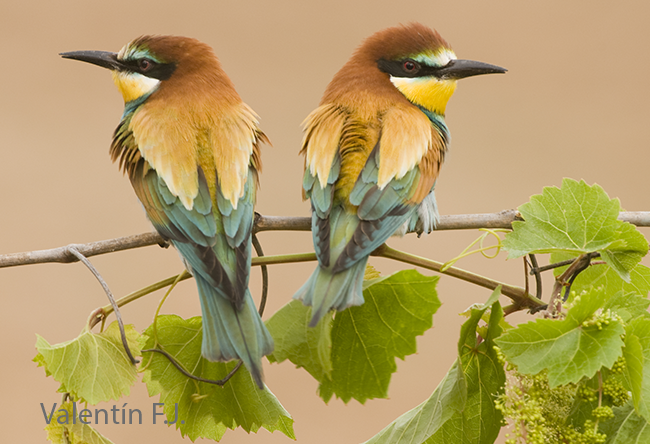Order: Coraciiformes.
Family: Meropidae.
There are no Iberian species that can be confused with the European Bee-eater.
Adult males have a brown color in both beards of the feathers of the greater, median, and lesser coverts. The back is brownish-red. On the other hand, adult females lack this brown color on the wing or have only a little (this part is usually limited to large and median coverts). The greater coverts centrals contain this brown only in the outer beard, adorned with a green-blue line, being the inner beard greenish. The back of females is brownish-green.
It is possible to recognize 3 different ages:
Juvenile specimen: has a greenish color in the neck feathers and the back. All the rectrices have the same length and lack the elongated tips of the central pair. The iris is dark brown or dark red.
2nd year specimen: similar to adults (including the elongated central pair of rectrices). They are recognized by preserving the juvenile primary coverts, worn and blue, contrasting with the green color of the surrounding feathers. Also, the primaries always with the same wear and color.
Adult specimen: with neck feathers and back of chestnut color. The central pair of rectrices with greater length than the others. The primary coverts are greenish without contrast with the neighboring feathers. The iris is of an intense reddish color. Specimens that started molting in breeding places show a difference in color and wear in primaries.
European Bee-eaters perform a complete postnuptial molt that begins in July with the body feathers. Some specimens molt some internal primaries (P1-P5) in their breeding areas to suspend the molt and finish it in wintering areas. On the other hand, there are specimens that do not start the wing molt until they reach their winter quarters. The post-juvenile molt is generally quite complete, but they retain all the juvenile primary coverts without molting. The flight feathers are never changed in the breeding areas. Both age types have a prenuptial molt.
Primaries: 10 per wing.
Secundaries: 14 per wing.
Rectrices: 12.


